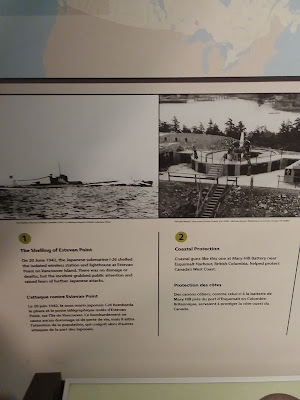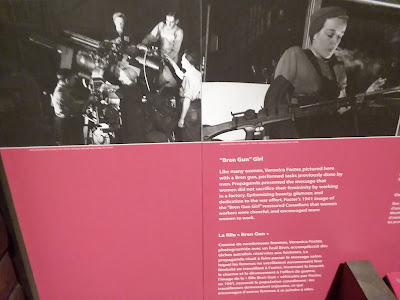Despite official policies of discrimination and suspicion, Canadians of Japanese background served with distinction and honour during the war.
A Japanese soldier of the era is depicted here, along with weapons.
Panels look at the measures Canada took to protect its west coast.
This painting is by Edward Hughes, titled Patrol, Kiska. In 1942, as part of its larger operations in the Pacific, the Japanese navy targeted Midway (one of the most decisive battles of the entire war, and a turning point for the Allies in the Pacific), but also sent some of their forces north to the Aleutians of Alaska, capturing the islands of Kiska and Attu, in the hopes of establishing bases there for operations into North America as a whole. The ground in these places was unsuited for bases and runways, and in 1943, a joint force of American and Canadian soldiers took the islands back.
Weapons of the era are here.
Propaganda posters start off a section looking at the war at home.
Women in the work place became a big thing during the war as part of the production for the war.













True: let's not forget the role of women...
ReplyDeleteIndeed.
DeleteSome scary weapons here William.
ReplyDeleteThat's true.
DeleteHe is not a Japanese soldier. He is a Canadian soldier and - if we must add it - of Japanese descent. Along with the residential school atrocities, the treatment of our fellow citizens because of their ancestry is one of the great stains on Canadian history.
ReplyDeleteI agree. Though in the case of what's in the display case, that is the uniform of a soldier in the Japanese military.
DeleteI like that poster wall.
ReplyDeleteMe too.
Delete'Kiska' in Hindi means 'Whose?' 😊
ReplyDeleteI would not have known.
DeleteThe Japanese internment was a horrible part of our history. Such a thing must never happen again!
ReplyDeleteDefinitely.
Delete...it's refreshing to hear that Canada had a sane policy about Canadians of Japanese background.
ReplyDeleteUnfortunately we did intern many.
DeleteI enjoy reading about the work women did during the war.
ReplyDeleteThey did a lot.
DeleteAnother great display and photos ~ Hope you are keeping warm ~
ReplyDeleteWishing you a happy day,
A ShutterBug Explores,
aka (A Creative Harbor)
It's quite cold today.
DeleteThe Aleutians are a strategic area that I believe, has a documentary or is part of one. The islands' part in WWII is fascinating.
ReplyDeleteIf often overlooked.
DeleteI have 2 friends of Japanese descent who were interned as small children. Their families lost everything.
ReplyDeleteThe architect who designed the Museum's present home was one of them.
DeleteWe treated our Japanese citizens very badly.
ReplyDeleteYes we did.
DeleteThe women contributed a lot during the war.
ReplyDeleteAll the best Jan
Yes they did.
DeleteThe US does not have a good plus on their record for their bad treatment of Japanese in WWII. I am grateful for those who served -- it must have been hard to take that role on a country where they may well still have had family.
ReplyDeleteThat's true.
DeleteShorts! Now that's my kind of uniform.
ReplyDeleteRequired in tropical climates.
DeleteOur local Japanese boys were the famed 442 go for broke battalion that has been so decorated. I'm excited to hear about the Canadian version of the story!
ReplyDeleteDaniel Inouye being the best example of them I can think of.
DeleteSo much information from the Canadian side! Thanks for sharing such detailed info, and the photos are wonderful.
ReplyDeleteYou're welcome.
Delete